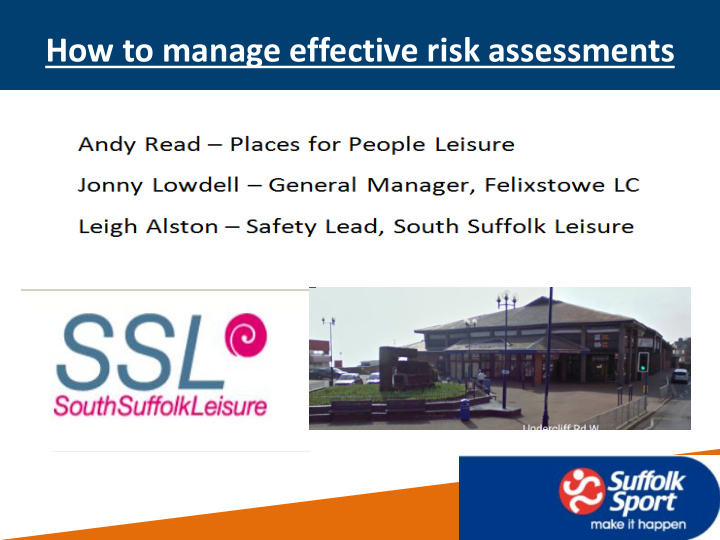



How to manage effective risk assessments
About me Safety Lead at PfP Leisure • 27 million annual visits – 8,000 staff Member of the • NSPCC/CPSU Leisure Centre Group • Ukactive Safety Group • Sub editor of the HSE’s ‘Managing Health and Safety in Swimming Pools’ Update • CIMSPA Midlands Board member • Suffolk Sport Board Member
How to manage effective risk assessments This workshop will discuss how to manage the risk assessment process covering areas involved in taking a school team to a competition and using facilities provided by/hired from another organisation.
Sporting Risk Assessments
Primary School Incident School Incident P
Councils fined after a child was found at the bottom of a swimming pool Both Aberdeen CC and Aberdeenshire Council pleaded guilty to safety breaches when they appeared in court. Court heard that in June 2012, 11yr old Primary School pupil attended Stonehaven Open Air Pool.. During the visit he submerged under water and was recovered unconscious by a member of the public. The party of 23 pupils (a teacher and teaching assistant) arrived with no formal booking. The pupils were allowed to swim in the pool which depth ranges from 0.8m to 2.2 m. While the pupils were using the pool and slide, a member of the public noticed a shadow under the water at the deep end. He found child lying on the bottom of pool, recovered the unconscious child and lifted to poolside.
Some initial questions 1. Why do you need to complete a risk assessment? 2. What responsibility has the centre to produce as risk assessment? 3. When the risk assessment has been completed – how is it used? 4. Who is the risk assessment shared with?
Jonny will lead discussion on what a General Manager is looking for? When should the risk assessment (RA) be completed How is it shared? Why ask the centre for a copy of their RA? Is a Fire RA needed? Do you really need to know about a Legionella RA? Why we need to manage ‘Poo in the Pool’
Safety checklist for classrooms Add front cover
Identify the hazards [1] 1. Decide who might be harmed and how [2] 2. Evaluate the risks and decide on precautions [3] 3. Record your significant findings [4] 4. Review your assessment and update if necessary [5] 5. Where you are confident you understand what's involved, you can do the assessment yourself. You don't have to be a health and safety expert. When thinking about your risk assessment, remember: a hazard is anything that may cause harm, such as chemicals, electricity, working from ladders, an open drawer etc the risk is the chance, high or low, that somebody could be harmed by these and other hazards, together with an indication of how serious the harm could be
Keep it simple If you think health and safety has to be complicated - it doesn't. http://www.hse.gov.uk/index.htm This site is for employers and those who want some basic information on what they must do to make sure their businesses comply with health and safety law. Yes….schools are business in safety’s view
Useful contacts Ukactive - http://www.ukactive.com/ CIMSPA - http://www.cimspa.co.uk/ Sport England - https://www.sportengland.org/ Football Association -http://www.thefa.com/ Amateur Swimming Association - http://www.swimming.org/asa/ Sports and Recreation - www.sportandrecreation.org.uk
Primary School What needs to be included and how the risks should be researched?
What does a risk assessment look like?
So where does this leave us ……? How to manage the risk assessment process covering areas involved in taking a school team to a competition and using facilities provided by/hired from another organisation?
Recommend
More recommend